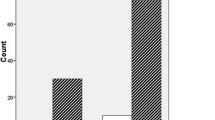Abstract
Postoperative bleeding is the most frequent surgical complication after tonsillectomy and may be associated with increased mortality rate. We have, therefore, analyzed factors associated with and prognostic for bleeding after tonsillectomy. The 2,254 patients who underwent tonsillectomy under general anesthesia at our institution from January 2005 to December 2009 were divided into bleeding and non-bleeding groups, and their demographic and clinical characteristics were compared. Age, administration of steroid immediately after general anesthesia, absence of administration of non-steroidal anti-inflammatory drugs, and the surgeon’s experience were significantly associated with bleeding. In contrast, gender, chief complaints, performance of associated surgery, and type of anesthetic were not associated with postoperative bleeding. Hemorrhage after tonsillectomy was associated with the administration of steroids and with the non-administration of non-steroidal anti-inflammatory drugs.
Similar content being viewed by others
References
Karaman M, Ilhan AE, Dereci G, Tek A (2009) Determination of optimum dosage of intraoperative single dose dexamethasone in pediatric tonsillectomy and adenotonsillectomy. Int J Pediatr Otorhinolaryngol 73:1513–1515
Krishna P, Lee D (2001) Post-tonsillectomy bleeding: a meta-analysis. Laryngoscope 111:1358–1361
Lee SW, Kim YS, Song TH, Cha YJ, Lee BD, Chang HS (1998) Clinical analysis of postoperative hemorrhage after tonsillectomy. Korean J Otolaryngol 41:1590–1593
Erdem AF, Yoruk O, Alici HA (2008) Subhypnotic propofol infusion plus dexamethasone is more effective than dexamethasone alone for the prevention of vomiting in children after tonsillectomy. Paediatr Anaesth 18:878–883
Czarnetzki C, Elia N, Lysakowski C (2008) Dexamethasone and risk of nausea and vomiting and postoperative bleeding after tonsillectomy in children: a randomized trial. JAMA 300:2621–2630
Egeli E, Akkaya S (1997) The effect of peritonsillar infiltration in tonsillectomy. Auris Nasus Larynx 24:179–183
Carmody D, Vamadevan T, Cooper SM (1982) Post tonsillectomy haemorrhage. J Laryngol Otol 96:635–638
Capper JW, Randall C (1984) Postoperative haemorrhage in tonsillectomy and adenoidectomy in children. J Laryngol Otol 98:363–365
Volk MS, Martin P, Brodsky L, Stanievich JF, Ballou M (1993) The effects of preoperative steroids on tonsillectomy patients. Otolaryngol Head Neck Surg 109:726–730
Vosdoganis F, Baines DB (1999) The effect of single dose intravenous dexamethasone in tonsillectomy in children. Anaesth Intensive Care 27:489–492
April MM, Callan ND, Nowak DM, Hausdorff MA (1996) The effect of intravenous dexamethasone in pediatric adenotonsillectomy. Arch Otolaryngol Arch Otolaryngol Head Neck Surg 122:117–120
Kristensen S, Tvesteras K (1984) Post-tonsillectomy haemorrhage: a retrospective study of 1150 operation. Clin Otolaryngol 9:347–350
Papangelou L (1972) Steroid therapy in tonsillectomy. Laryngoscope 82:297–301
Kim MS, Coté CJ, Cristoloveanu C (2007) There is no dose-escalation response to dexamethasone (0.0625–1.0 mg/kg) in pediatric tonsillectomy or adenotonsillectomy patients for preventing vomiting, reducing pain, shortening time to first liquid intake, or the incidence of voice change. Anesth Analg 104:1052–1058
Gan TJ, Meyer TA, Apfel CC (2007) Society for Ambulatory Anesthesia. Society for Ambulatory Anesthesia guidelines for the management of postoperative nausea and vomiting. Anesth Analg 105(6):1615–1628
Kay DJ, Mehta V, Goldsmith AJ (2003) Perioperative adenotonsillectomy management in children: current practices. Laryngoscope 113:592–597
Allford M, Guruswamy V (2009) A national survey of the anesthetic management of tonsillectomy surgery in children. Paediatr Anaesth 19:145–152
Macassey EA, Baguley C, Dawes P, Gray A (2007) 15-year audit of post-tonsillectomy haemorrhage at Dunedin Hospital. ANZ J Sur 77:579–582
Collison PJ, Mettler B (2000) Factors associated with post-tonsillectomy hemorrhage. Ear Nose Throat J 79:640–642
Brigger MT, Cunningham MJ, Hartnick CJ (2010) Dexamethasone administration and postoperative bleeding risk in children undergoing tonsillectomy. Arch Otolaryngol Head Neck Surg 136:766–772
Cardwell M, Siviter G, Smith A (2005) Non-steroidal anti-inflammatory drugs and perioperative bleeding in paediatric tonsillectomy. Cochrane Database Syst Rev 18(2):3591
Author information
Authors and Affiliations
Corresponding author
Additional information
M. K. Kim and J. S. Lee contributed equally to this work.
Rights and permissions
About this article
Cite this article
Kim, M.K., Lee, J.W., Kim, M.G. et al. Analysis of prognostic factors for postoperative bleeding after tonsillectomy . Eur Arch Otorhinolaryngol 269, 977–981 (2012). https://doi.org/10.1007/s00405-011-1697-5
Received:
Accepted:
Published:
Issue Date:
DOI: https://doi.org/10.1007/s00405-011-1697-5




